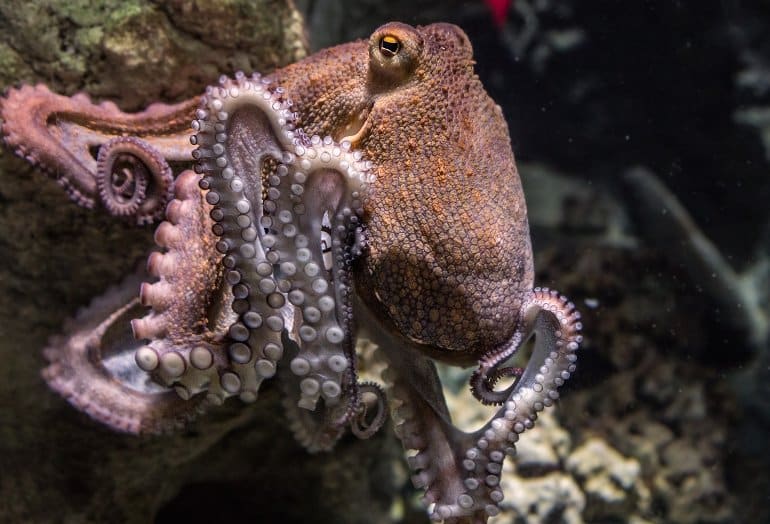
Summary: Cephalopod neural stem cells function similarly to those of vertebrates during the development of the nervous system.
Source: Harvard
Cephalopods — which include octopuses, squid, and their squid cousins — are capable of some truly charismatic behaviors. They can quickly process information to change shape, color, and even texture to blend in with their environment. They can also communicate, show signs of spatial learning, and use problem-solving tools. They are so smart that they can even get bored.
It’s no secret what makes it possible: cephalopods have the most complex brains of any invertebrate on the planet. However, the process remains a mystery. Basically, scientists have long wondered how cephalopods get their big brains in the first place?
A Harvard lab studying these soft-bodied creatures’ visual system — which focuses two-thirds of their central processing tissue — thinks they’re almost there to figure it out. The process, they say, is surprisingly familiar.
Researchers at the FAS Center for Systems Biology describe how they were able to observe the formation of neurons in the embryo in near real time using a new live imaging technique. They were then able to follow these cells through the development of the nervous system in the retina. What they saw surprised them.
The neural stem cells they tracked behaved eerily similar to those cells in vertebrates during the development of their nervous systems.
It suggests that although vertebrates and cephalopods differed from each other 500 million years ago, not only do they use similar mechanisms to make their large brains, but that this process and the way the cells act divide and are formed, can essentially design the required blueprint develop this type of nervous system.
“Our conclusions were surprising because much of what we know about the development of the nervous system in vertebrates has long been thought to be specific to this lineage,” said Kristen Koenig, John Harvard Distinguished Fellow and senior author of the study.
“By observing the fact that the process is very similar, it suggested to us that these two independently evolved, very large nervous systems use the same mechanisms to build them. This suggests that these mechanisms – these tools – that animals use during development may be important in building large nervous systems.”
The Koenig Lab scientists focused on the retina of a squid named Doryteuthis pealeii, more commonly known as a type of longfin squid. The squid grow to about a foot in length and are abundant in the Northwest Atlantic. As embryos, they look pretty adorable with big heads and big eyes.
Researchers used techniques similar to popular ones to study model organisms such as fruit flies and zebrafish. They developed special tools and used state-of-the-art microscopes that could take high-resolution images every ten minutes for hours to see how individual cells behaved. The researchers used fluorescent dyes to mark the cells so they could map and track them.
This live imaging technique allowed the team to observe stem cells, called neural progenitor cells, and their organization. The cells form a special type of structure called pseudostratified epithelium. Its main feature is that the cells are elongated, allowing them to pack tightly.
The researchers also saw the core of these structures moving up and down before and after the division. This movement is important for keeping tissue organized and for growth to continue, they said.
This type of structure is universal to how vertebrate species develop their brains and eyes. Historically, it was thought to be one of the reasons why the vertebrate nervous system was able to grow so large and complex. Scientists have observed examples of this type of neural epithelium in other animals, but the squid tissue they examined in this case was unusually similar to vertebrate tissue in its size, organization, and the way the cell nucleus moved.
The research was led by Francesca R. Napoli and Christina M. Daly, research associates at the Koenig Lab.
Next, the lab wants to investigate how different cell types develop in the brains of cephalopods. Koenig wants to determine if they are expressed at different times, how they choose to become one type of neuron versus another, and whether this action is similar across species.
Koenig is excited about the potential discoveries that lie ahead.
“One of the great takeaways from this type of work is the value of studying the diversity of life,” Koenig said. “By studying this diversity, you can actually come back to fundamental ideas about our own development and our own biomedically relevant questions. You can really respond to these questions.”
About this news from neuroscientific research
Author: Juan Siliezar
Source: Harvard
Contact: Juan Siliezar—Harvard
Picture: The image is in the public domain
Original research: Closed access.
“Development of the cephalopod retina reveals vertebrate-like mechanisms of neurogenesis” by Kristen Koenig et al. Current Biology
abstract
The development of the cephalopod retina reveals vertebrate-like mechanisms of neurogenesis
highlights
- Retinal progenitor cells in squid undergo interkinetic nuclear migration
- Progenitor cells, postmitotic and differentiated cells are transcriptionally defined
- Notch signaling can regulate both retinal cell cycle and cell fate in squid
summary
Coleoid cephalopods, including cuttlefish, cuttlefish, and cuttlefish, have large and complex nervous systems and camera-like eyes with high acuity. These traits are comparable only to traits that evolved independently in the vertebrate lineage.
The size of animal nervous systems and the diversity of their constituent cell types is a result of the tight regulation of cell proliferation and differentiation during development.
Changes in the developmental process during evolution that result in a diversity of nerve cell types and variable size of the nervous system are not well understood.
Here we developed live imaging techniques and conducted functional interviews to show that the squid Doryteuthis pealeii utilizes mechanisms during retinal neurogenesis that are hallmarks of vertebrate processes.
We find that retinal progenitor cells in squid undergo nuclear migration until they exit the cell cycle. We identify the retinal organization corresponding to progenitor, postmitotic, and differentiated cells.
Finally, we find that Notch signaling can regulate both retinal cell cycle and cell fate. Given the convergent evolution of sophisticated visual systems in cephalopods and vertebrates, these results reveal common mechanisms underlying the growth of highly proliferative neurogenic protozoa.
This work sheds light on mechanisms that alter ontogenetic allometry and may contribute to the development of complexity and growth in animal nervous systems.










